Top Rankings
Galveston Independent School District ranks among the top 20% of public school district in Texas for:
Category
Attribute
Diversity
Most diverse schools (Top 1%)
Community Size
Largest student body (number of students) (Top 1%)
For the 2025 school year, there are 8 public elementary schools serving 3,437 students in Galveston Independent School District. This district's average elementary testing ranking is 6/10, which is in the top 50% of public elementary schools in Texas.
Public Elementary Schools in Galveston Independent School District have an average math proficiency score of 40% (versus the Texas public elementary school average of 42%), and reading proficiency score of 51% (versus the 52% statewide average).
Minority enrollment is 76% of the student body (majority Hispanic), which is more than the Texas public elementary school average of 75% (majority Hispanic).
Overview
This School District
This State (TX)
# Schools
14 Schools
6,902 Schools
# Students
6,446 Students
3,737,053 Students
# Teachers
466 Teachers
255,471 Teachers
Student : Teacher Ratio
14:1
14:1
District Rank
Galveston Independent School District, which is ranked #809 of all 1,196 school districts in Texas (based off of combined math and reading proficiency testing data) for the 2021-2022 school year.
The school district's graduation rate of 88% has increased from 86% over five school years.
Overall District Rank
#819 out of 1204 school districts
(Bottom 50%)
(Bottom 50%)

Math Test Scores (% Proficient)
32%
41%

Reading/Language Arts Test Scores (% Proficient)
46%
51%
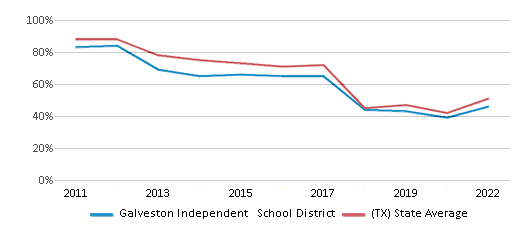
Science Test Scores (% Proficient)
35%
46%
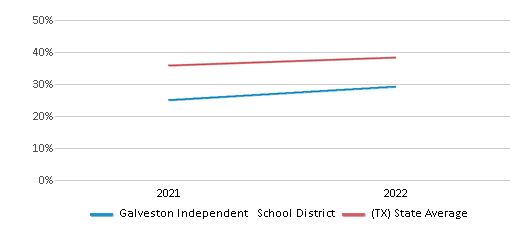
Graduation Rate
88%
90%
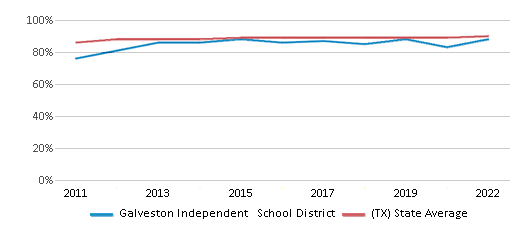
Students by Ethnicity:
Diversity Score
0.66
0.64
# American Indian Students
15 Students
11,705 Students
% American Indian Students
n/a
n/a
# Asian Students
101 Students
203,767 Students
% Asian Students
2%
6%
# Hispanic Students
3,086 Students
1,997,454 Students
% Hispanic Students
48%
53%
# Black Students
1,480 Students
469,194 Students
% Black Students
23%
13%
# White Students
1,575 Students
924,841 Students
% White Students
24%
25%
# Hawaiian Students
7 Students
5,879 Students
% Hawaiian Students
n/a
n/a
# Two or more races Students
182 Students
124,213 Students
% of Two or more races Students
3%
3%
Students by Grade:
# Students in PK Grade:
413
222,501
# Students in K Grade:
422
346,866
# Students in 1st Grade:
463
385,427
# Students in 2nd Grade:
470
402,148
# Students in 3rd Grade:
458
399,623
# Students in 4th Grade:
487
398,690
# Students in 5th Grade:
435
399,071
# Students in 6th Grade:
396
402,143
# Students in 7th Grade:
428
335,034
# Students in 8th Grade:
446
339,814
# Students in 9th Grade:
618
32,833
# Students in 10th Grade:
522
28,116
# Students in 11th Grade:
445
23,862
# Students in 12th Grade:
443
20,925
# Ungraded Students:
-
-
District Revenue and Spending
The revenue/student of $15,857 is higher than the state median of $13,387. The school district revenue/student has stayed relatively flat over four school years.
The school district's spending/student of $17,869 is higher than the state median of $14,116. The school district spending/student has stayed relatively flat over four school years.
Total Revenue
$102 MM
$74,029 MM
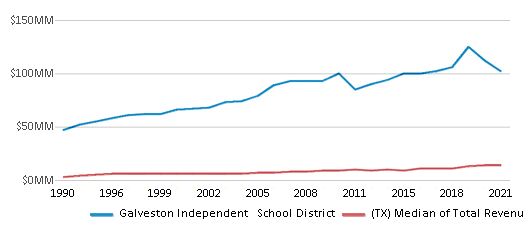
Spending
$115 MM
$78,063 MM
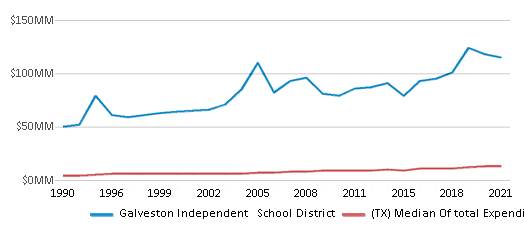
Revenue / Student
$15,857
$13,387
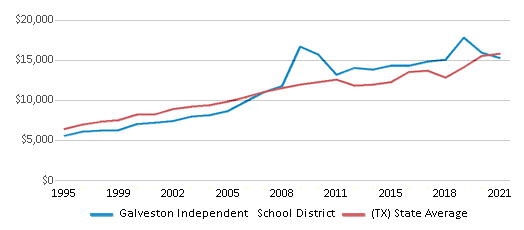
Spending / Student
$17,869
$14,116
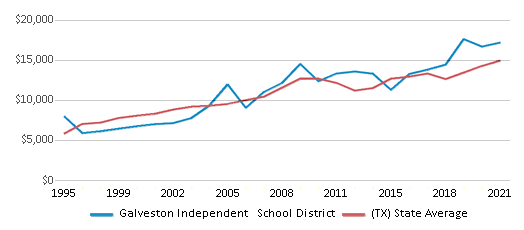
Best Galveston Independent School District Public Elementary Schools (2025)
School
(Math and Reading Proficiency)
(Math and Reading Proficiency)
Location
Grades
Students
Rank: #11.
Austin Middle School
(Math: 65% | Reading: 80%)
Rank:
Rank:
10/
Top 10%10
1514 N 1/2
Galveston, TX 77553
(409) 761-3500
Galveston, TX 77553
(409) 761-3500
Grades: 5-6
| 392 students
Rank: #22.
Oppe Elementary School
(Math: 66% | Reading: 70%)
Rank:
Rank:
10/
Top 10%10
2915 81st St
Galveston, TX 77553
(409) 761-6500
Galveston, TX 77553
(409) 761-6500
Grades: PK-4
| 624 students
Rank: #33.
Morgan El Magnet School
Magnet School
(Math: 55-59% | Reading: 55-59%)
Rank:
Rank:
8/
Top 30%10
1410 37th St
Galveston, TX 77553
(409) 761-6700
Galveston, TX 77553
(409) 761-6700
Grades: PK-4
| 572 students
Rank: #44.
Parker Elementary School
(Math: 45-49% | Reading: 50-54%)
Rank:
Rank:
7/
Top 50%10
6802 Jones Dr
Galveston, TX 77553
(409) 761-6600
Galveston, TX 77553
(409) 761-6600
Grades: PK-4
| 440 students
Rank: #55.
Rosenberg El Laboratory For Learning And Leading
(Math: 25-29% | Reading: 40-44%)
Rank:
Rank:
3/
Bottom 50%10
721 10th St
Galveston, TX 77553
(409) 761-6800
Galveston, TX 77553
(409) 761-6800
Grades: PK-4
| 315 students
Rank: #6 - 76. - 7.
Burnet Elementary School
(Math: 25-29% | Reading: 35-39%)
Rank:
Rank:
3/
Bottom 50%10
5501 Ave S
Galveston, TX 77553
(409) 761-6470
Galveston, TX 77553
(409) 761-6470
Grades: PK-4
| 556 students
Rank: #6 - 76. - 7.
Crenshaw El And Middle School
(Math: 25-29% | Reading: 35-39%)
Rank:
Rank:
3/
Bottom 50%10
406 Hwy 87
Galveston, TX 77553
(409) 684-8526
Galveston, TX 77553
(409) 684-8526
Grades: PK-8
| 133 students
Rank: #88.
Weis
Magnet School
(Math: 9% | Reading: 23%)
Rank:
Rank:
1/
Bottom 50%10
7100 Stewart Rd
Galveston, TX 77553
(409) 761-6100
Galveston, TX 77553
(409) 761-6100
Grades: 5
| 405 students
Recent Articles

Year-Round Or Traditional Schedule?
Which is more appropriate for your child? A year-round attendance schedule or traditional schedule? We look at the pros and cons.

Why You Should Encourage Your Child to Join a Sports Team
Participating in team sports has a great many benefits for children, there is no doubt. In this article you will learn what those benefits are.

White Students are Now the Minority in U.S. Public Schools
Increasing birth rates among immigrant families from Asia and Central and South America, combined with lower birth rates among white families, means that for the first time in history, public school students in the United States are majority-minority. This shift in demographics poses difficulties for schools as they work to accommodate children of varying language abilities and socio-economic backgrounds.





